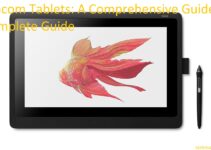Are you looking for the perfect tablet to unleash your artistic vision? Then look no further!
With Procreate, you can now easily master digital art and unleash your inner artist. Our complete guide will help you find the best tablet tailored to your needs so that you can take control of your creativity.
Creating digital art can be a great addition to any artist’s repertory since it offers a huge range of possibilities and applications. From drawing and painting, to animation and web design – the options are limitless. You can even replicate a traditional medium, such as watercolour or looped animation, using digital tools. Whether you create digital art as part of your professional practice or just for fun, finding the right tools is an important step in order to achieve optimal results. The best way to start out on your creative journey is with tablets designed specifically for creating digital artwork.
Tablets come in all shapes and sizes nowadays, so finding one that will meet your needs can feel like a rather daunting task. To make sure you pick the right tablet for creating digital art, you need to consider features such as resolution, pressure sensitivity levels, portability and battery life. There are many tablets on the market that cater to different preferences and needs, so let’s explore some popular models from different price brackets! This complete guide will help give you an idea of what each tablet has to offer so that you can pick the perfect match for your own creative projects.
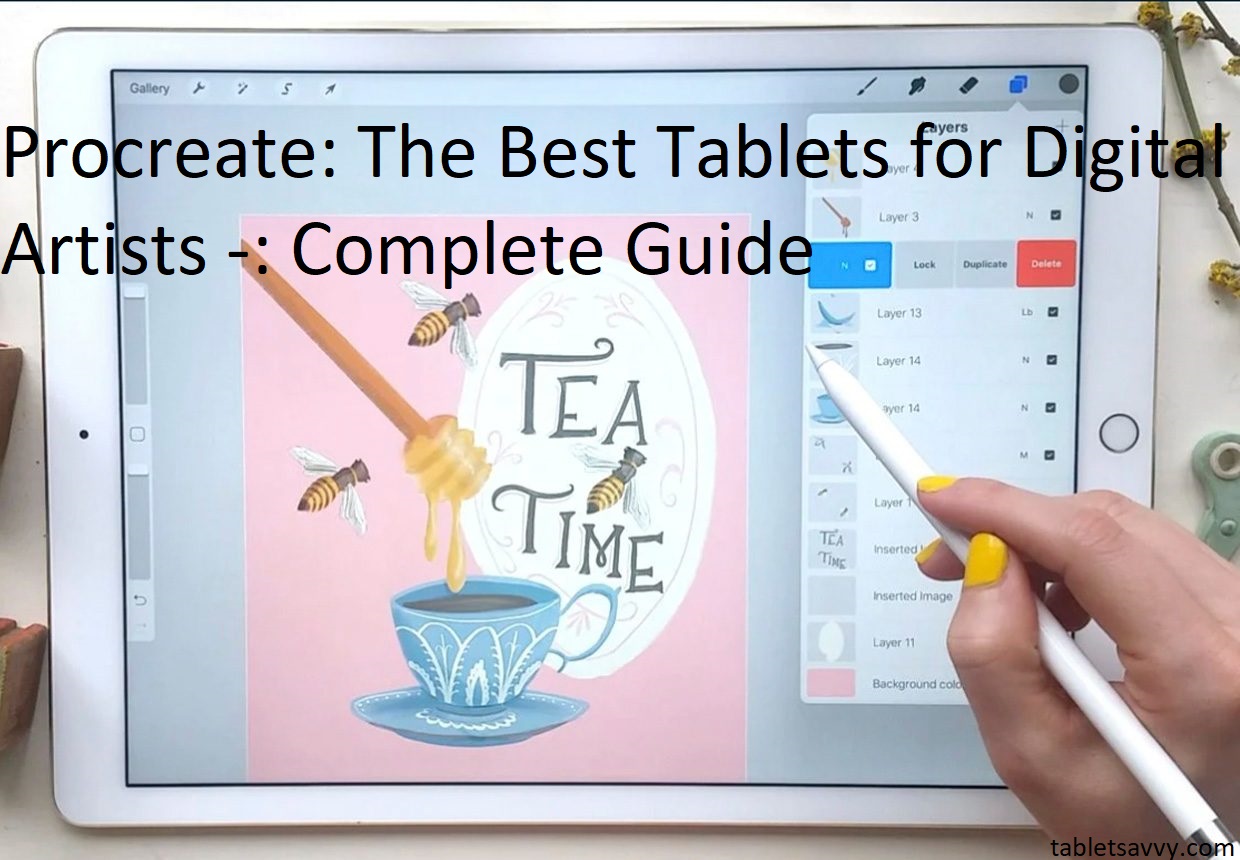
Explanation of Procreate and its importance
Procreate is a raster graphics editor created by Savage Interactive, a software company based in Hobart, Australia. It is the primary digital drawing app available exclusively on Apple’s iOS, iPadOS and MacOS platforms. The app was designed and built for professional creatives who use it to create beautiful works of art effortlessly and quickly.
Procreate combines intuitively designed user interfaces with powerful painting tools that allow users to produce art that looks like it was created traditionally on paper or canvas. The app also makes collaboration easy, enabling artists to share their work-in-progress with friends and colleagues so they can get feedback as they create.
The core features of Procreate make digital drawing easier than ever before: its naturally responsive brushes enable artists to easily draw smooth lines or painterly textures anywhere using just their finger or an Apple Pencil; its wide selection of customizable tools allows users to transform photos into paintings without fuss; its studio lighting helps bring artwork to life in three dimensions; and its powerful layering system allows artists to layer images for full creative control over tone, contrast, saturation and more.
Thanks to Procreate’s steady growth over the past few years, digital art is becoming increasingly popular—and choosers are spoiled for choice when it comes to finding the best tablets for completing their projects.
Overview of tablets for digital artists
Tablets are an important tool for digital artists, as they allow for on-the-go creation and the ability to work without being tied to desk. They come in a wide range of sizes, specs, prices and features that can make finding the right tablet for your needs overwhelming. That’s why we’ve broken down some of the key things you should consider when purchasing a tablet for digital art so that you can be sure to buy one that meets your needs.
Size: One of the most important considerations when buying a tablet is size – both physical dimensions and screen space. Tablets come in different sizes, so it’s important to consider what size is the best fit for you before making a purchase. If you travel often or like to work on-the-go then a smaller tablet will be easiest to carry with you; if you usually work from your desktop then having more screen space is likely more beneficial than portability.
Pressure response: Pressure response is the way that devices measure how hard the pen or stylus presses against the surface of the screen – meaning how sensitively it responds under varying levels pressure. The higher level of pressure response, generally meaning less pressure needed to achieve different shades (2000+ on most tablets) means that drawing becomes more natural and easier; many digital artists even prefer working with near no pressure at all but this might not be possible depending on manufacturer settings within basic tablet models.
Battery life: Although many tablets come with built-in batteries, they are not typically rechargeable or replaceable once they have worn out; meaning if yours starts running out quickly or stops charging altogether then replacing it might be necessary. Look into battery life when shopping around as this will ensure uninterrupted use during extended bouts of drawing or painting sessions away from an outlet or laptop!
Importance of selecting the right tablet for digital art
The right tablet for digital art can be a major factor in the success of an artist’s work. Tablets provide an alternate way to draw, paint, and create with a computer. They come in many shapes and sizes, with some offering features like pressure-sensitivity or detachable keyboards. Some tablets are better-suited for particular tasks than others, making it important for digital artists to select the right tool for their project.
The average consumer will generally be content with basic features such as colour accuracy, wide range of stylus options and a resolution of 1-2k. However, professionals and experienced digital artists will require more sophisticated tablets that offer higher levels of pressure sensitivity, improved multi-touch reading functions and angles, plus adjustable resolution up to 4K or higher depending on the project size and complexity. Advanced features such as the inclusion of a built-in pen displays with Embedded Display Techonology (EDT) should also be taken into consideration when selecting the right tablet for digital art.
In short, selecting the right tablet is essential if you want to achieve desired results both in terms of quality and speed when creating digital artwork. Each individual artist’s needs are different which is why researching which one is best suited to you is key in order to get the most out of your creative endeavors!
Purpose of the guide
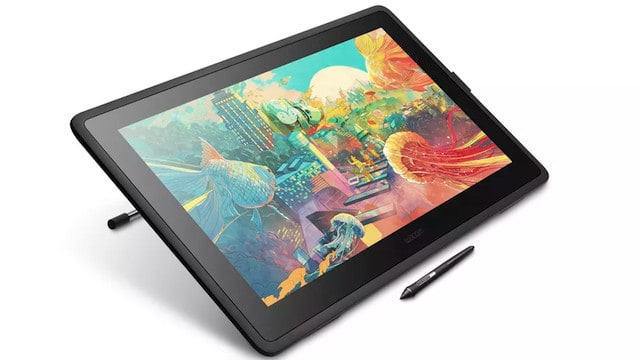
The purpose of the guide is to provide digital artists with an in-depth overview of the current best tablets suited for digital art on the market. There has been an increasing array of tablets available in recent years and it can be difficult to know which one to choose.
This comprehensive guide provides professional reviews and analysis of each tablet model’s performance, graphics capabilities, design and price, enabling users to make informed decisions about which tablet would best suit their individual needs.
After reading this guide, users should feel confident in their ability to identify and purchase a tablet that will exceed their expectations for digital art.
Factors to Consider when Choosing a Tablet
When choosing the best tablet for your digital art needs, there are several important considerations you should beware of. Here are the most important things to think about:
- Operating system: The operating system of a tablet will affect the available software and its overall performance. Common operating systems include iOS and Android, but some tablets also have their own OS such as Windows or Chrome OS.
- Size: It is important to consider the size of a tablet as it affects its portability as well as level of comfort when using it for long periods of time. If you travel frequently and don’t want to be confined to your desk then look for more compact options that won’t weigh down your bag too much.
- Display quality: The display is one of the most important components in any device geared towards digital art and design, so choose a tablet with a good quality screen that produces bright colors, rich blacks and great viewing angles. Avoid low-end models with washed out displays as its effects can be truly discouraging for any creative projects.
- Connectivity options: Many professional artists use external peripherals such as pens or styluses to draw digitally but only some tablets offer support for them so make sure you pick a model compatible with common interactive tools used by creatives today. It’s also worth considering whether wireless features like Bluetooth might come in handy when working from multiple locations or machines such as when using Wacom’s remote desktop solution for example.
- Battery life & other features: Finally, battery life should be taken into account since nobody likes having their work interrupted by an empty battery symbol halfway through a drawing session or meeting. Other factors like storage capacity or support for external storage solutions like USB drives might also come in handy depending on what type of projects you intend on taking up in the future so consider these carefully before making your final decision.
Size and Resolution
The size and resolution of the screen you choose makes a big difference in how comfortable it is to draw on. Most serious digital artists prefer tablets with 15” screens, though 12” or 13” work well for regular or frequent use as well. The main advantage to getting a larger tablet is the ability to see more of your artwork at one time, allowing you to spend less time zooming in and out.
Tablets also come with different resolutions. The higher the resolution, the more detailed your artwork will be and the more crisp lines you’ll be able to achieve. It’s important to consider both size and resolution when choosing a tablet for digital art. Higher resolutions like 4K are best for large-scale projects that require lots of detail, but standard HD resolutions will work great for day-to-day drawing if portability is a priority.
Display Type
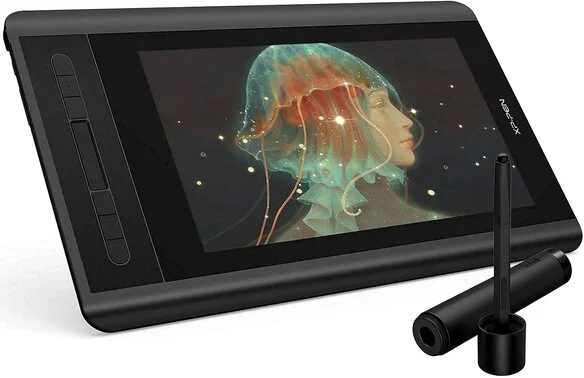
When looking for a tablet for digital artwork, the display is one of the most important components. Not all displays are created equal, and there are many different types to choose from. We’ll go into detail about three of the most popular types.
LCD (Liquid Crystal Display) An LCD is a flat-panel type of display and is readily available in devices such as phones and tablets. They have great color accuracy and good viewing angles, but they can lack when it comes to brightness levels compared to other types of displays such as OLED or IPS technology.
OLED (Organic Light Emitting Diode) This is a newer type of display that offers excellent brightness levels but can sometimes be limited by battery drain faster than an LCD or IPS display if turned on at high brightness levels often. Great when it comes to dark colors, they offer wide color gamut coverage as well as deep blacks. They have better viewing angles than LCD screens but don’t have the same level of color accuracy as an IPS type display panel.
IPS (In-Plane Switching) This type of display offers excellent accuracy when it comes to colors along with wider viewing angles compared with both LCD and OLED screens, so it’s ideal for artists who create highly detailed artwork where accurate colors are key elements in the final product.
Pressure Sensitivity
Pressure sensitivity is the amount of pressure that is applied to the tablet or pen stylus. In procreate, you have access to up to 8192 pressure levels which increase your drawing accuracy, allowing for smooth gradients and lines.
The amount of pressure sensitivity will vary with different devices and it is important for any digital artist to consider this in order to get the most precise control when creating their artwork.
Tablets with a higher pressure sensitivity level will provide smoother lines, as well as more variations on line thickness depending on how much force is applied. The quality of a device’s pen technology also affects how accurately pressure levels are detected and translated into brush strokes. Keep in mind that some tablets may require additional accessories in order to achieve the appropriate level of pressure sensitivity required for sophisticated artwork.
Battery Life
An important factor to keep in mind when selecting a tablet for digital art is the battery life. Obviously, you don’t want a tablet that lasts for mere minutes before needing to be plugged in again. Since professional digital artists may be working on their projects for hours at a time, it’s important to invest in a tablet that can fit your needs and keep you powered up throughout the duration of your artwork.
The battery life of each tablet will depend on various factors such as the model and type of device, settings being used, and accessories being used. Therefore, always check reviews or research online to get an idea of what other users are experiencing with each device. Set times like two or three hours should give you an approximation as to how long the battery will last before it needs recharging. Some tablets are advertised with long battery life claims such as twelve hours or more; however it is essential to research further into their specific use cases before making your final purchase decision.
Additionally, look into options like having multiple batteries so that if one runs out of power during use you can switch quickly without having long pauses between drawing sessions.
Storage Capacity
Storage capacity is one of the most important considerations when buying a tablet for digital art. The amount of storage you need often depends on the types of artwork you’ll be creating. A digital artist working with complex 3D images and renders may require more storage than a digital illustrator creating simple compositions. It’s usually recommended that buyers look for tablets with at least 64GB of internal storage, although some artists may need up to 256GB or even higher.
Additionally, it’s also possible to expand the storage capacity with external memory cards and hard drives, although these can add more cost.
Connectivity Options
When it comes to digital tablets, connectivity options are an important factor that help users take advantage of their creative efforts and turn them into products. Depending on the type of tablet you choose, there is a variety of connectivity options available to you.
The two primary types of connection are wired and wireless, so take a moment to decide which type would be more suitable for your needs. If you want an uninterrupted connection, it’s best to choose a wired connection like USB or HDMI cables. This means you won’t have to worry about battery life or wireless signal strength but it may limit your portability somewhat if your computer is tethered in one spot.
On the other hand, if the convenience of being able to move around while still creating your art is important, then selecting a wirless solution could be ideal for you. Wireless solutions typically offer faster speeds and better range than wired solutions, however they may require more special consideration with regards to battery life and signal strength depending on what device you use. Popular wireless protocols include Bluetooth and WiFi (N/AC/AD).
Graphics tablets often come with both types of connections so that users can enjoy the best of both worlds — corded performance with convenience of being untethered by cords or wires when working away from their desks or labs.
- Cost
- Cost is an important factor to consider when choosing the right tablet for creating digital art. Though they can generally be pricier investments upfront, the payoff of high-quality digital equipment and features may be worth it in the long run.
Some cheaper tablets on the market have limited capabilities and are not suitable for professional-level art creation, while others provide powerful features and performance with a wide range of customization options at slightly higher prices. Additionally, many tablets come with bundles that can offer extra accessories at discounted rates, such as protective cases, styluses or warranty coverage.
This article should help you determine which tablet best fits your creative needs without breaking your budget.
Conclusion
In conclusion, if you’re looking for the best tablet for digital art, each of the tablets mentioned have their strengths. Whether it’s value for money with the iPad Pro, vast range of features and specs with the Microsoft Surface Pro 7, or extra power and portability from the Wacom MobileStudio Pro 16 – you can now make an informed decision on which one is right for your needs as a digital artist.
Each of these can undoubtedly give you a great experience when creating digital art but remember to consider all of your specific requirements such as portability, budget and software compatibility before making a final decision. With this guide in hand, you should be able to find the perfect tablet that will help bring your creative visions to life.
FAQ’s
What is the best art tablet for Procreate?
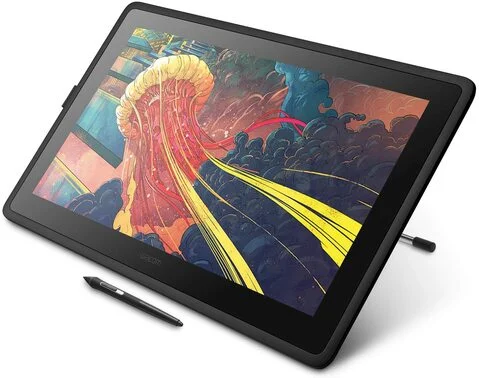
The iPad Pro is considered the best tablet for Procreate due to its powerful hardware and optimized software.
What tablet is best for digital art?
Apart from iPad Pro, other tablets like Wacom MobileStudio Pro, Microsoft Surface Pro, and Samsung Galaxy Tab S7 are also great options for digital art.
What is the best device to use Procreate on?
The best device to use Procreate on is the iPad Pro with Apple Pencil as it provides a seamless and natural drawing experience.
How much RAM do I need for Procreate?
Procreate requires a minimum of 2GB RAM but 4GB or more is recommended for smoother performance.
Is 256gb enough for Procreate?
Yes, 256GB is enough for Procreate, but it depends on the number of layers and size of the artwork files you create.
How big is 1 Procreate file?
The size of a Procreate file depends on the number of layers, canvas size, and image resolution. It can range from a few megabytes to several gigabytes.
Is Procreate heavy?
Procreate is a powerful and feature-rich app, but it is optimized to run smoothly on Apple’s iPad and iPad Pro.
Is 64GB okay for Procreate?
64GB is okay for Procreate, but it may not provide enough storage space if you create large and complex artwork files.
Is 8GB of RAM enough for Procreate?
Yes, 8GB of RAM is enough for Procreate, but higher RAM provides better performance and smoother experience.
What is the minimum iPad for Procreate?
The minimum iPad for Procreate is the iPad 4th generation, but the app runs smoothly on iPad Air, iPad Mini 2, and newer models as well.
See Also:
- Best tablet for cricut design space 2023
- Best tablet under 300 2023
- Best tablet for emulation 2023
- Best tablet for teachers 2023
- Best tablet for musicians 2023
